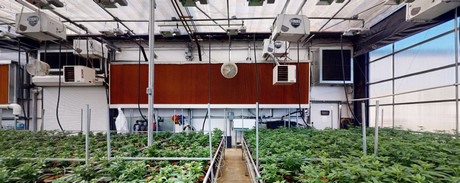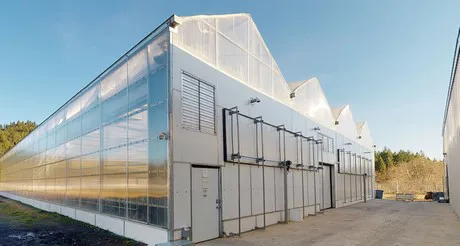In this second part of the series on choosing the right greenhouse, we are going to further explore the influences of external climate on the building, and what kind of structures are more suitable to specific conditions. Then, we are going to discuss light deprivation greenhouses and why these are especially advised for cannabis growing. Finally, we conclude with a discussion on the importance of automation. If you have missed the first part, click here to catch up!
Choosing the right greenhouse (and equipment) for your climate can not be overstated in its importance. It’s better to have a single, small greenhouse that will produce a good yield and not cave in than to have 10 structures that cannot keep up with or will collapse under climate conditions.
In places with moderate, sunny climates with a relatively low humid harvest season (areas like Northern California and Southern Oregon), growers can utilize budget hoop houses, rain covers, or hand-pulled blackout systems with little to no equipment and still pull off one to two harvests without a whole bunch of risk. However, if you’re anywhere humid, hot, windy, extra rainy, or if you have huge temperature swings - this method won’t work. Even with mild temperatures, without proper automation and a properly equipped greenhouse, these growers can only pull 2 turns per year. So many growers with a decent budget will choose to use greenhouses and climate control automation that will allow for growing year-round.

In places with very cold winters, huge temperature swings, and/or high snow/wind load conditions, a budget greenhouse simply won’t work. Using an engineered structure that is built for these conditions is essential to keeping your crop safe from cave-ins and huge temperature swings. Budget growers can still use a traditional non-light dep greenhouse, and pull one (or two) turns with the necessary heating and ventilation automation. This works well for areas that can drop dead cold in the winter, but you don’t have to combat high summer temps or humidity. Still, using full-on environmental controls and a light deprivation system would allow for 3-5 turns if the budget permits.

In places with very hot or humid summers, there’s no way around using an automated system and a tall greenhouse if you want a decent chance at a successful harvest. Using a tall structure like a 35’ wide, 40’wide, or Gutter Connected Greenhouse will allow to keep the heat and humidity off the plants and cool the greenhouse down easier. As heat and humidity rise together, taller structures provide for less drastic temperature swings at canopy height. Engineered structures can have ridge vents and other passive means of removing hot and humid air. Additionally, many hot climates will need things like evaporative cooling walls, shade cloth, fogging systems, and more. The cost to produce in a hot/humid climate is going to be higher but you’ll have a much better product than your local outdoor growers while keeping your overhead lower than the average indoor grower.
To use Light Deprivation or Not
100% go for light deprivation for your cannabis greenhouse, if you can afford it. If you can’t, get a standard greenhouse first and use your profits to get a light dep system on it later. Using light deprivation allows you to control the photoperiod and force the plants to flower multiple times per year. This gets you high-quality harvests when everyone else is out of product to move. If you do have to opt for a traditional greenhouse and plan on getting light deprivation added later, you want to make sure you choose a greenhouse that can support a light deprivation system. Light deprivation systems are heavy and require a very strong, straight, and level greenhouse. Fullbloom offers both budget-friendly automated exterior roll-to-peak systems and automated interior cable-driven systems for more extreme climates.
Exterior Roll-to-Peak Cannabis Greenhouses
Roll-to-Peak blackout systems use motors (if automated) and steel or aluminium tubing to roll the blackout material from the ground on either side, up to the roof of your greenhouse where it will sit open exposing the sunlight to your plants. This is vastly more economical both on the equipment purchase and on the install than the interior curtain systems. However, the roll-to-peak systems can only be used in low wind, very low snow climates, or by growers who plan on taking the winter off and winterizing their greenhouse to sit dormant. You can use a roll-to-peak blackout system on everything from a tiny hoop house to a massive 35’x144’ semi gable. Although the latter isn’t advised unless you get a professional roll-to-peak blackout system like the ones we fabricate at Fullbloom.
Interior Blackout/Light Dep Cannabis Greenhouses
Using a blackout system that tracks on the inside of a greenhouse can be necessary depending on your climate. Anywhere with wind gusts over 40mph or more then 1ft of snow that can come down at any given time should be using an internal blackout system. When the blackout system is on the inside of the greenhouse, it can be operated in any weather condition provided your greenhouse frame is fully covered. Our customers in northern states, coastal areas, and other windy areas almost exclusively use interior blackout greenhouses, as doing otherwise will risk losing your blackout system and your entire crop. An interior curtain system is complicated, heavy, and expensive. Since the weight of another frame mounted to the interior of the greenhouse frame is quite heavy, the greenhouse it’s built-in has to be able to support the weight and connection points. That is why you won’t be able to just buy a regular budget greenhouse and install an interior curtain system later. Fullbloom custom engineer greenhouses specifically to handle the weight of an interior curtain system and whatever wind/snow and weather you might have. You can even find structures through us that allow for an exterior dep system to start, while still giving you the option to upgrade to an interior system down the road.
Worry-Free Automation
Automation can come at a high upfront cost, but it can make scaling up and reducing risk so much easier for a proper cannabis project. Nearly everything can be automated now, from heating, cooling, dehumidification, CO2 injection, passive air removal, blackout systems, watering, nutrients, the list goes on and on. What you choose should be dependent on your budget, your available staff to harvest and tend to the plans, and your climate. Growers in moderate climates can get away with minimal automation and maybe use a standard temperature probe for their greenhouse, or simply open sidewalls. Anyone with a farm in an area with high-temperature swings, extreme heat, or cold will need an intuitive environmental controller that will allow you to integrate all of your equipment into a seamless operation. While this comes at a price, it also allows you to grow much better flower that will get a lot more profit per/lb and you significantly mitigate the risk of losing your entire crop. Most environmental controllers also allow you to record data points, giving you a better leg up on your next round of growing.
For more information:
Fullbloom Greenhouse
500 Rossanley Dr. Medford, OR 97501
1-866-252-9641
contact@fullbloomlightdep.com
fullbloomlightdep.com
